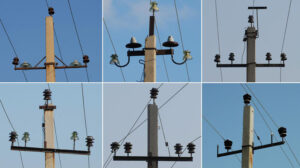Third International Scientific and Practical Conference “Eagles of the Palearctic: Study and Conservation”
Raptors Conservation. Suppl. 2. Proceedings of Conferences
Low efficiency of “blank” insulators used to protect birds on overhead power lines
Matsyna A.I. (Environmental Center “Dront”, Nizhny Novgorod, Russia)
Contact:
Alexander Matsyna OrnothoLab@mail.ru
Recommended citation: Matsyna A.I. Low efficiency of "blank" insulators used to protect birds on overhead power lines. – Raptors Conservation. 2023. S2: 388–389. DOI: 10.19074/1814-8654-2023-2-388-389 URL: http://rrrcn.ru/en/archives/35153
The results of a special research carried out in the arid zone in the territory of the Republic of Kalmykia (Russia) demonstrate the low efficiency of "blank" insulators installed earlier on 6–10 kV overhead power lines (OPLs) as bird protection devices (BPDs). The materials of inspection of territories with different types of 6–10 kV power lines, not equipped with "blank" insulators and any types of BPDs were used as a comparative material. It was found that on average that 1.62 dead birds (of all species) are encountered per one kilometer of 6–10 kV power lines equipped with "blank" insulators. For territories of similar power lines, not equipped with additional insulators, the average frequency of encounters is 1.77 dead birds per 1 km of power lines. Thus, the use of "blank" insulators shows insignificant reduction of bird hazard – on average by 8 % compared to the control, and cannot be characterized as a measure sufficient to ensure the safety of wildlife during the operation of overhead power lines. As a result of the research there are numerous cases in which the installation of "blank" insulators and their subsequent operation leads to the opposite effect – bird hazard of 6–10 kV overhead power lines equipped in this way increases.

Different options for caps of power line supports with blank insulators. The metal rod exposed by the decayed blank insulator (bottom right) significantly increases the overall bird hazard of the structure. Photo from the RRRCN website.
